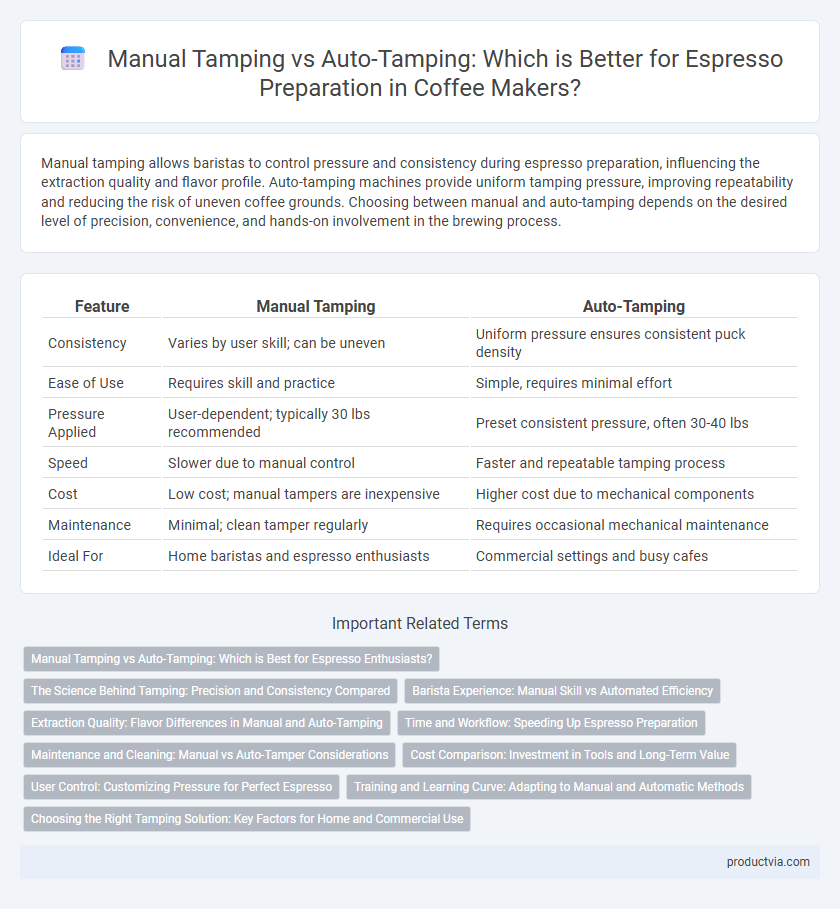Manual tamping allows baristas to control pressure and consistency during espresso preparation, influencing the extraction quality and flavor profile. Auto-tamping machines provide uniform tamping pressure, improving repeatability and reducing the risk of uneven coffee grounds. Choosing between manual and auto-tamping depends on the desired level of precision, convenience, and hands-on involvement in the brewing process.
Table of Comparison
| Feature | Manual Tamping | Auto-Tamping |
|---|---|---|
| Consistency | Varies by user skill; can be uneven | Uniform pressure ensures consistent puck density |
| Ease of Use | Requires skill and practice | Simple, requires minimal effort |
| Pressure Applied | User-dependent; typically 30 lbs recommended | Preset consistent pressure, often 30-40 lbs |
| Speed | Slower due to manual control | Faster and repeatable tamping process |
| Cost | Low cost; manual tampers are inexpensive | Higher cost due to mechanical components |
| Maintenance | Minimal; clean tamper regularly | Requires occasional mechanical maintenance |
| Ideal For | Home baristas and espresso enthusiasts | Commercial settings and busy cafes |
Manual Tamping vs Auto-Tamping: Which is Best for Espresso Enthusiasts?
Manual tamping offers espresso enthusiasts precise control over coffee grounds compression, allowing adjustments tailored to espresso machine pressure and grind consistency. Auto-tamping machines provide consistent pressure and streamline the brewing process, reducing human error and improving repeatability for daily espresso preparation. Choosing between manual and auto-tamping depends on user preference for control versus convenience in achieving optimal espresso extraction.
The Science Behind Tamping: Precision and Consistency Compared
Manual tamping allows baristas to control pressure and angle, directly influencing espresso extraction quality through tactile feedback and subtle adjustments. Auto-tamping machines deliver uniform pressure with precise calibration, enhancing consistency and reducing variability in shot quality. Scientific studies show that consistent tamping pressure, typically around 30 pounds-force (lbf), is essential for optimal espresso crema and flavor extraction.
Barista Experience: Manual Skill vs Automated Efficiency
Manual tamping in espresso preparation allows baristas to apply personalized pressure and technique, enhancing control and enabling subtle adjustments that reflect their expertise. Auto-tamping systems deliver consistent pressure and standardized tamping force, reducing variability and speeding up the workflow for high-volume settings. While manual tamping showcases the barista's craft and skill, auto-tamping prioritizes efficiency and uniformity, influencing the overall quality and consistency of each espresso shot.
Extraction Quality: Flavor Differences in Manual and Auto-Tamping
Manual tamping allows precise control over pressure and distribution, often resulting in richer, more nuanced espresso flavors due to consistent extraction. Auto-tamping offers uniform pressure application, minimizing human error and producing stable, repeatable shots, though some enthusiasts report slightly less complexity in taste. The difference in extraction quality hinges on the barista's skill level and the machine's tamping consistency, influencing the overall flavor profile of the espresso.
Time and Workflow: Speeding Up Espresso Preparation
Manual tamping requires precise pressure and can slow down the workflow, especially during busy periods when consistent tamping speed is crucial. Auto-tamping machines deliver uniform pressure rapidly, reducing preparation time and minimizing variability in espresso shots. This efficiency makes auto-tamping ideal for commercial settings aiming to speed up espresso preparation without sacrificing quality.
Maintenance and Cleaning: Manual vs Auto-Tamper Considerations
Manual tampers require regular cleaning of the base to prevent coffee residue buildup, ensuring consistent pressure during espresso extraction, while auto-tamping machines often feature removable parts designed for easy maintenance and automated cleaning cycles. Maintaining a manual tamper demands careful attention to hygiene to avoid flavor contamination, whereas auto-tamper systems reduce the risk of human error and simplify upkeep with scheduled cleaning alerts. Choosing between manual and auto-tamping depends on balancing the hands-on maintenance effort versus convenience and consistent hygiene provided by automated systems.
Cost Comparison: Investment in Tools and Long-Term Value
Manual tamping requires a lower initial investment with a basic tamper costing between $15 and $50, while auto-tamping machines can range from $200 to over $1,000. Over time, manual tamping tools offer durability and easy replacement, minimizing long-term expenses compared to the higher maintenance and potential repair costs of auto-tamping systems. The cost-effectiveness of manual tamping appeals to budget-conscious espresso enthusiasts, whereas auto-tamping provides consistency at a premium price point, impacting overall value depending on usage frequency and skill level.
User Control: Customizing Pressure for Perfect Espresso
Manual tamping allows users to adjust pressure precisely based on coffee grind size and personal taste, enhancing flavor extraction and espresso quality. Auto-tamping provides consistent pressure with minimal effort, ideal for maintaining uniformity but limiting customization flexibility. Experienced baristas often prefer manual tamping to fine-tune espresso strength and crema, while beginners benefit from the reliability of auto-tamping systems.
Training and Learning Curve: Adapting to Manual and Automatic Methods
Manual tamping requires consistent pressure and technique, demanding focused training to achieve uniform espresso extraction, which can be challenging for beginners. Auto-tamping machines simplify this process by delivering consistent tamping pressure, reducing the learning curve and ensuring repeatable results with less skill. Training for manual tamping emphasizes developing muscle memory and precise control, while automatic tamping shifts focus to mastering machine settings and maintenance.
Choosing the Right Tamping Solution: Key Factors for Home and Commercial Use
Choosing the right tamping solution for espresso preparation depends on factors such as consistency, ease of use, and volume of coffee production. Manual tamping allows for precise pressure control and customization, ideal for home baristas seeking hands-on experience. Auto-tamping machines offer uniform pressure and speed, enhancing efficiency and consistency in busy commercial environments.
Manual tamping vs Auto-tamping for Espresso Preparation Infographic

 productvia.com
productvia.com